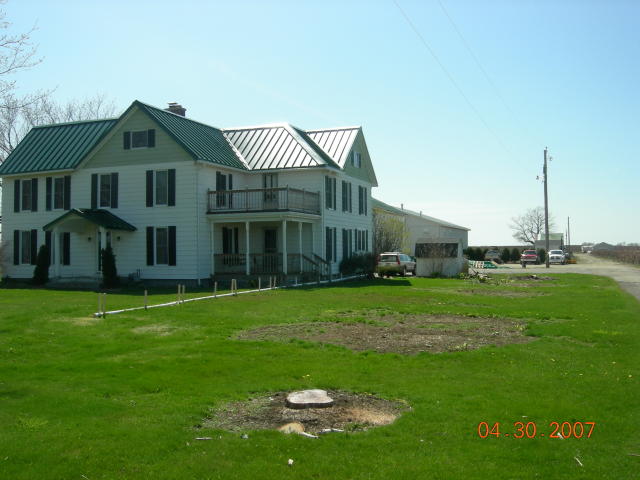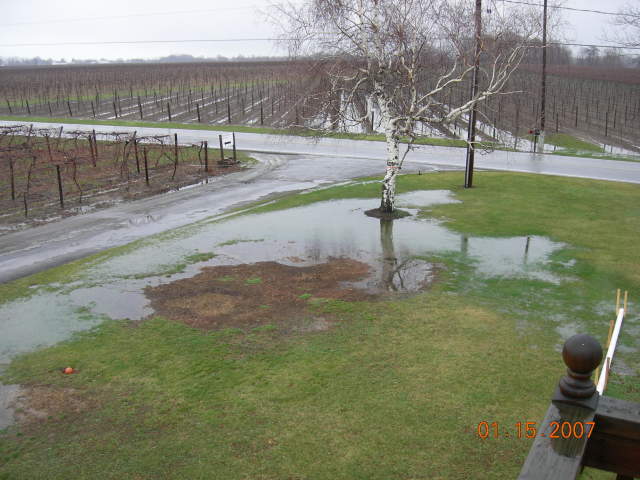Question House with sump draina
House with sump draina
QUESTION: Please see attached image which will make my question m ake more sense. I, fortunately or unfortunately, have an underground spring running beneath my house. When the water table rises, water enters the rench drain system and is pumped out via two sump pumps (150 gal/min and 50 gal/min I believe). During the fall, winter, and early spring, the pumps are running almost constantly.
Originally, both drainage pipes exited the north side of my house and directly onto the ground and foundation. I believe the majority of the water was seeping right back into the frech drain system.
Our plumber told us we had to reroute the water far enough away from our house to aviod the same water issues with standing water within 4-5 feet of our foundation. We did just that and now we are stuck with this ugly 4-inch PVC pipe extending 40 feet in front of the house and 80 feet from the drainage pipe exits.
Our property to the north (where the exits are) only extendeds 15-20 feet from the foundation to the neighbor's black-topped driveway. We have no public sewer drain. And our septic installer said it would be too much water for the existing, brand new septic system.
Our property is as flat as a ruler, and we are 0.5 mile south of Lake Erie in North East, PA.
The west side of our property (the right rear of the photo) is a black-topped driveway and parking pad in front of our barn / garage. We have 80+ feet to the east (towards the main road), and two acres to the south (the opposite side of the drainage exits).
Do you have any ideas or suggestions on how I can better manage the drainage? If I am stuck with the PVC pipe, how can I incorporate it into a landscaping design?
Currently, the pipe is disconnected as we are rototilling and weeding around the house. Any guidance would be greatly appreciated.
ANSWER: Robert,
All I can say is...Wow. 200 gph is alot of water to deal with.
I have to admit, this is no small problem. I agree with your plumber - you have to get that water up and away from the foundation and the house. And the 4" surface line really doesn't scream custom landscaping.......double whammy.
Ultimately, I would consult with a civil engineer who is familiar with your local codes and proper storm water run-off best practices for your city/town. He would be the expert.
IDEA #1: As far as my humble opinion goes, it seems that the amount of water you are dealing with is too great to just send down the asphalt pad or onto the surface of the grass. In addition, it is too great to send underground into a collection sump. Instead of running the PVC pipe above ground and spilling onto the grass as it shows in the picture, can you send it below ground and then resurface into an area of your property that would allow for a retention basin? This retention basin would need to be big enough to temporary hold the bulk of the water while at the same time allowing controlled overflow to escape out and onto the acreage. This controlled release would prevent overflow of the basin and also prevent flooding of your property. Also, you could incorporate the basin into the existing landscape as a water feature, etc.
IDEA #2: NDSPRO.com makes multiple items for underground drainage. You could run UNDERGROUND 4" solid corrugated pipe from the exits of the house 40' into the yard and then switch to 4" perforated corrugated for 40' more feet. This perforated would need a silt sock around it as well as buried in about 2-3' of gravel. The idea here is the water would run 40' from the house and then dissipate through the perforated pipe back into the soil and ground water. This ultimately would just be recycling the water, but it would take it away from your house.
No easy answer here. Either way, I see alot of digging involved. Check back with me if you have more questions or come up with a different solution.
Good luck - BC
---------- FOLLOW-UP ----------
 Ponding
Ponding
QUESTION: Thank you very much for your suggestions, I appreciate it! Referring to the attached photo, you can see about how much and where the water ponds.
I believe we are going to temporarily move the PVC pipe to parallel the driveway directly in line with the pole and surround it with large rocks or maybe a dense hedge. At the discharge end of the pipe, we are considering placing a rock bed. The birch tree is no longer there.
Do you have any creative ideas to hide / cover the 80+/- feet of 4-inch PVC? Hostas, azaleas, rock wall, etc.?
Thank you!
AnswerRobert,
If you are building a rock bed to collect the water at the end of the run, then a dry river bed with plantings would tie in nicely to that. This may be tough to pull off, though. You will want to build the river bed up and around the pipe and then use a mixture of shrubs and trees to add texture, color, and variety. Plant in clumps as you travel down the river bed making sure that you keep a natural look and feel. You would tie in the planting in and around the rock bed. The idea here is to use the plantings to soften the shape and harshness of the rock; making the rock look secondary. I would use mostly shrubs and deciduous trees (no birch!) instead of perennials.
If this was my yard, I would spend the extra money and build a small (2' x 18") dry stack rock wall along the edge of the driveway. You could build this wall around the pipe, effectively embedding the pipe inside. I would expand the wall every so often and create a planter pocket that could recieve a columnar shrub or perennial planting. This would soften the wall as well. I think this would frame the driveway, hide the pipe, and tie in nicely with the rock bed. Dry stack walls are tough, but when done properly, look FANTASTIC!
Let me know how things go. - BC







